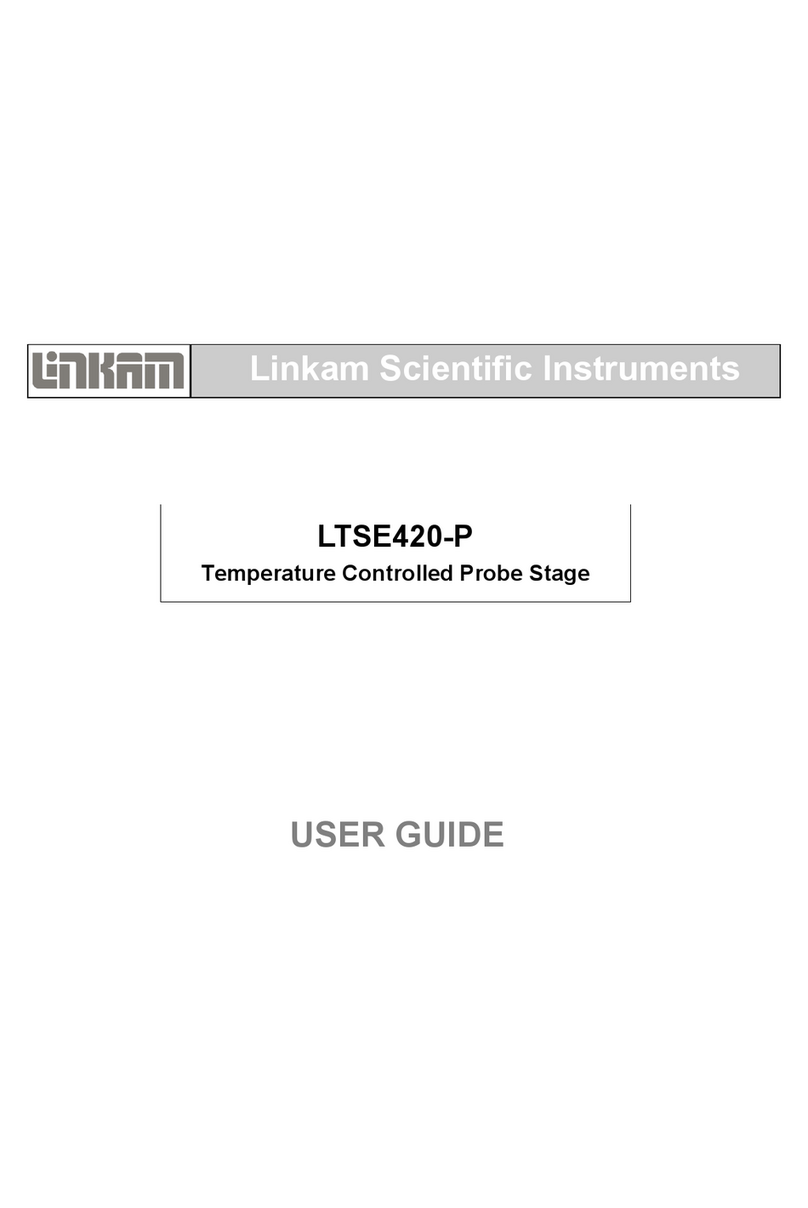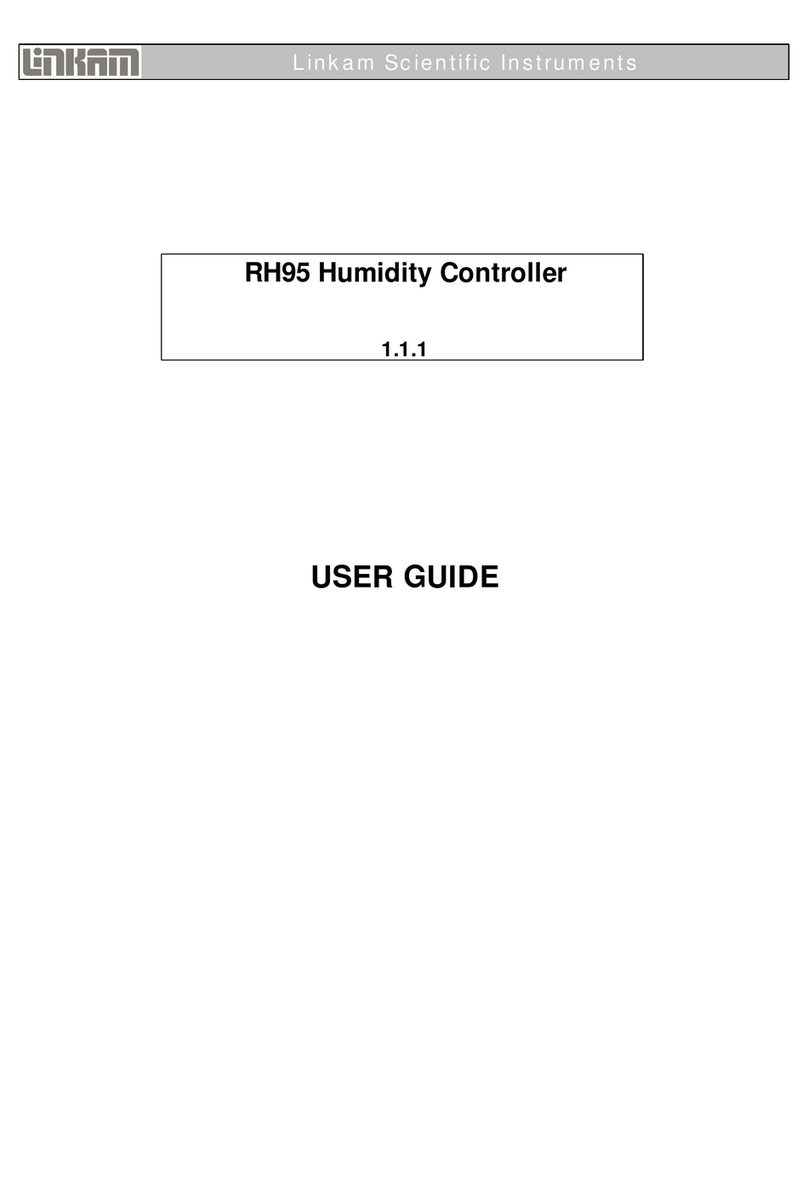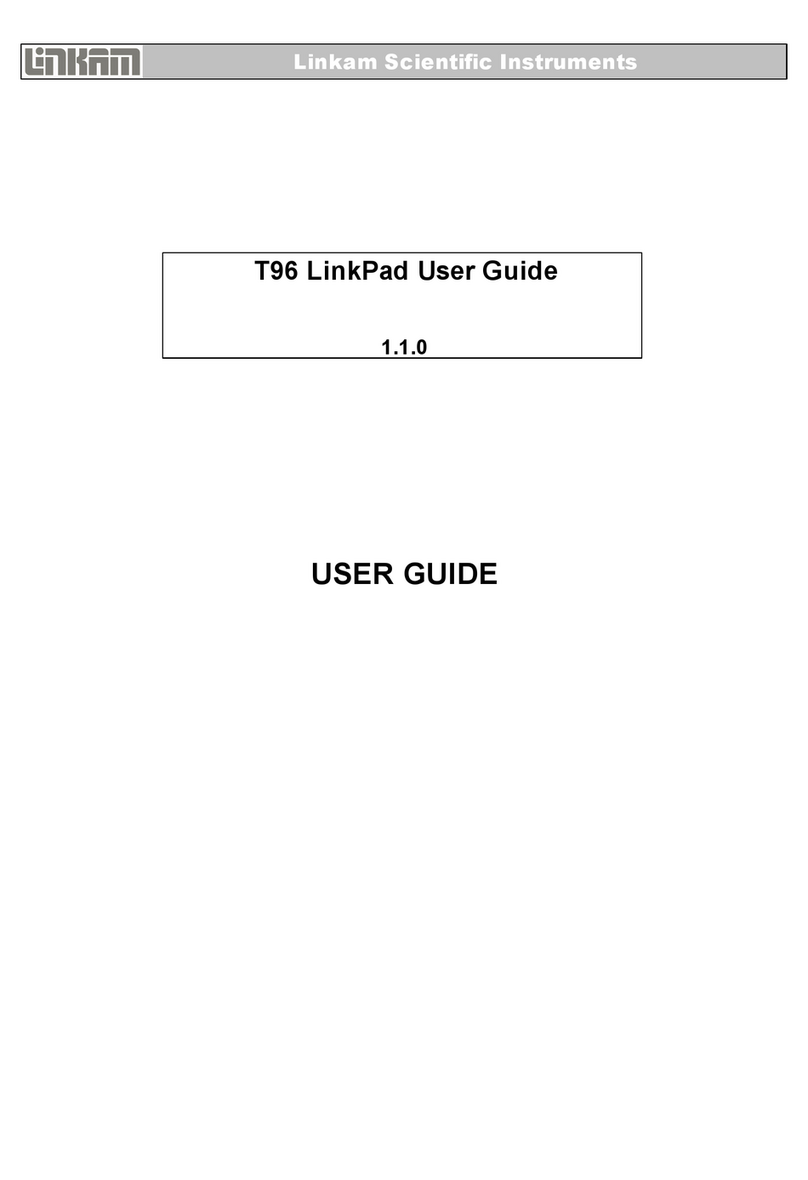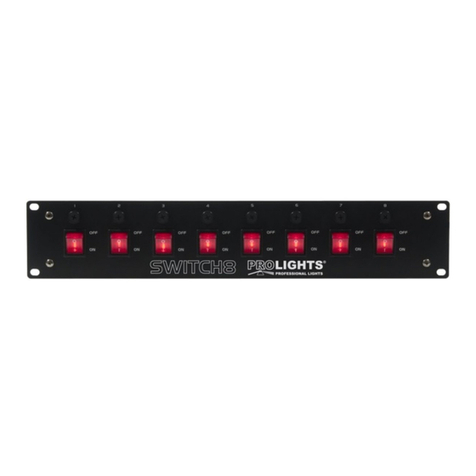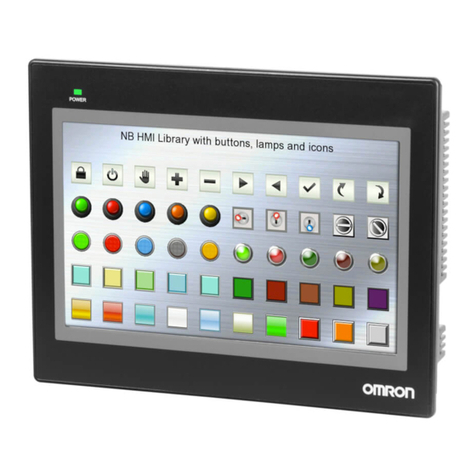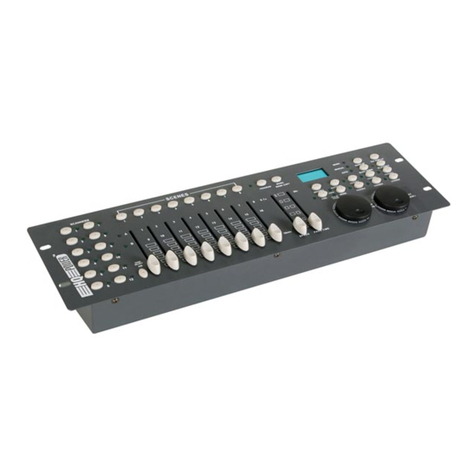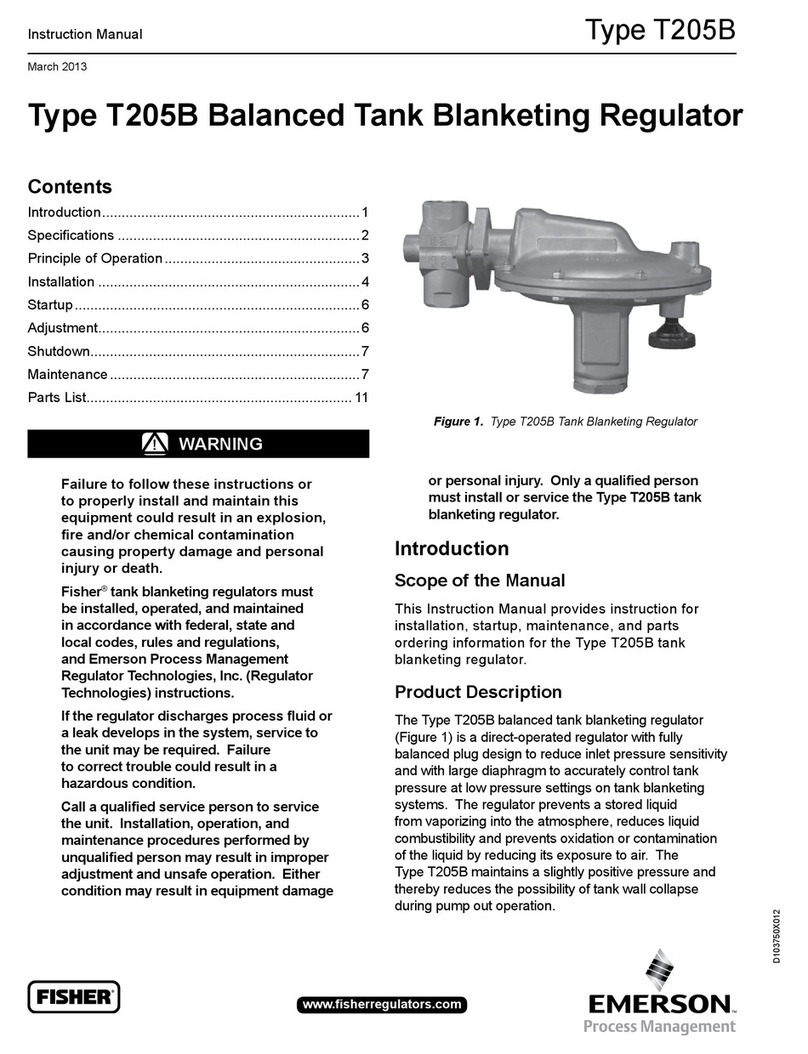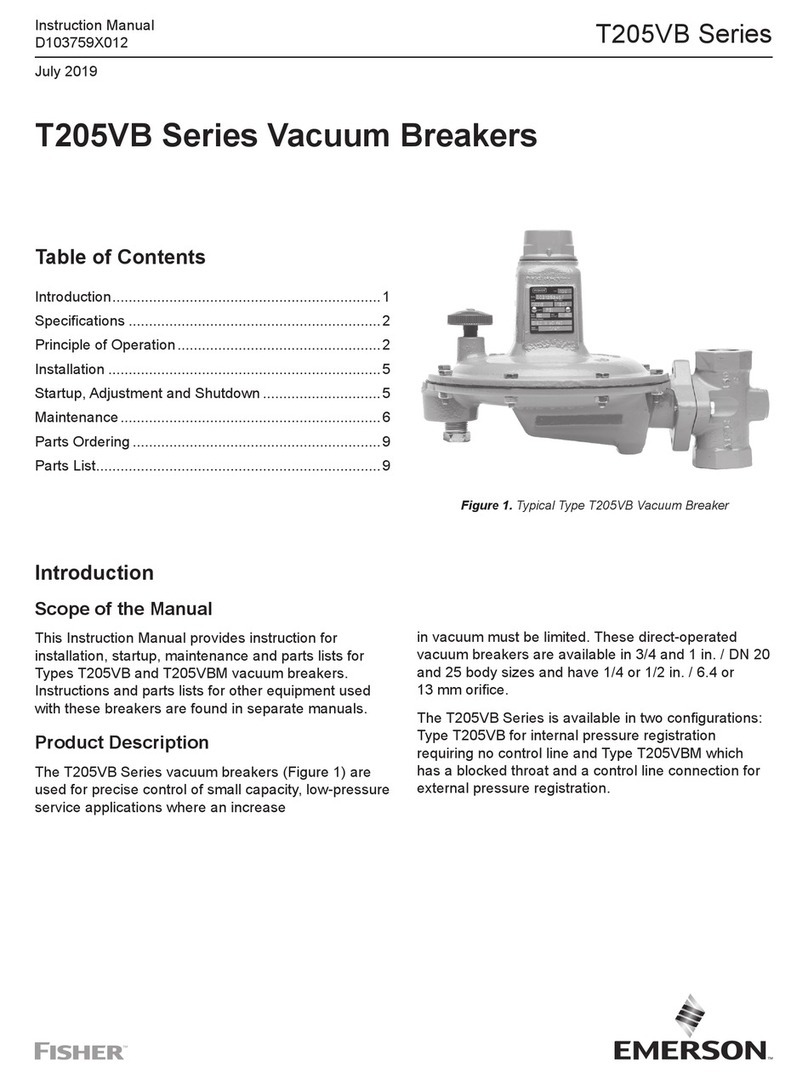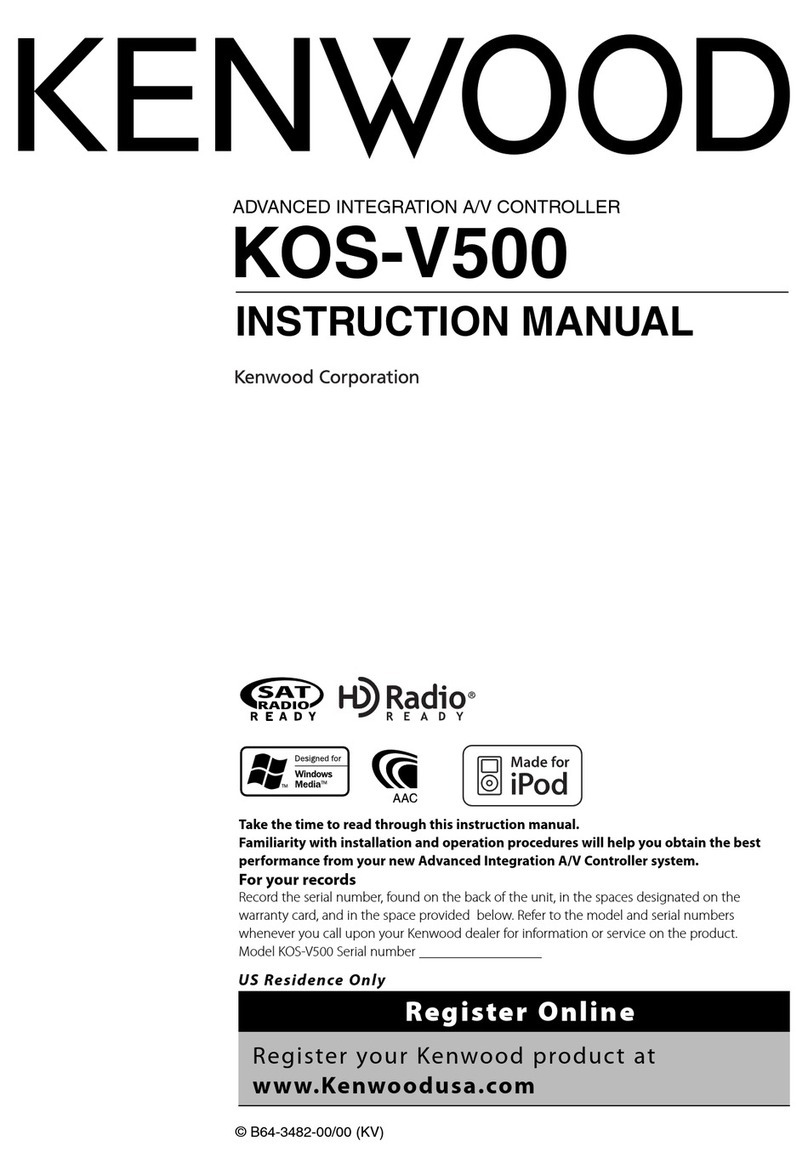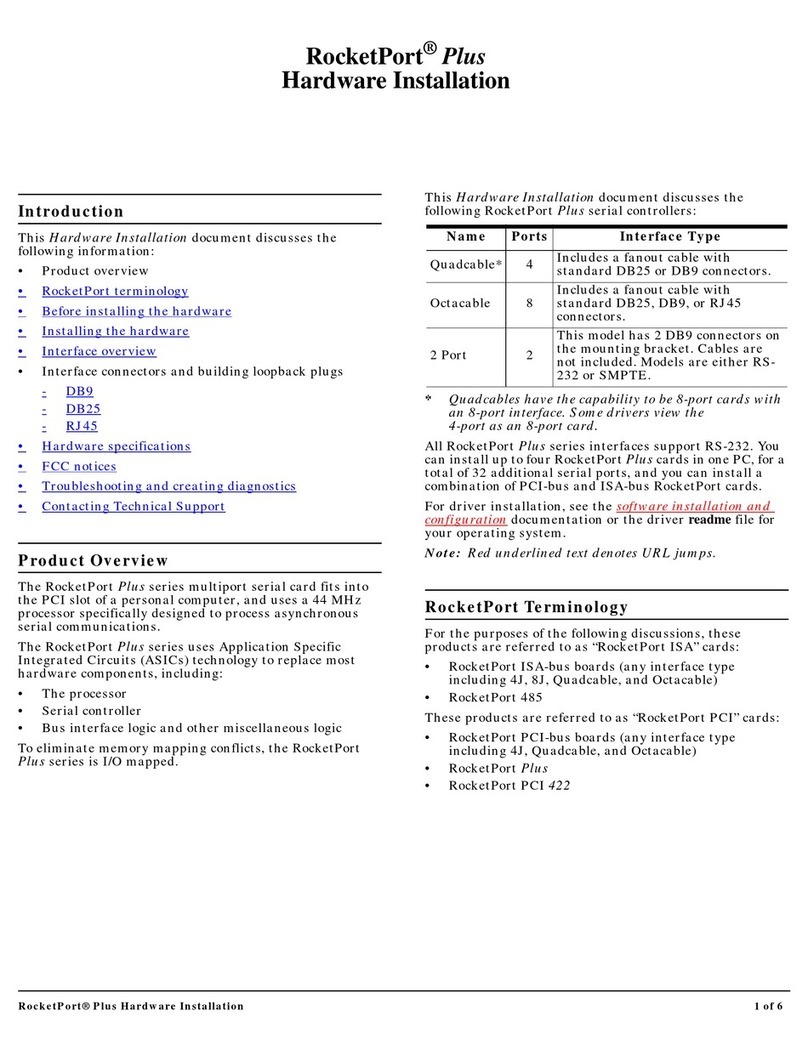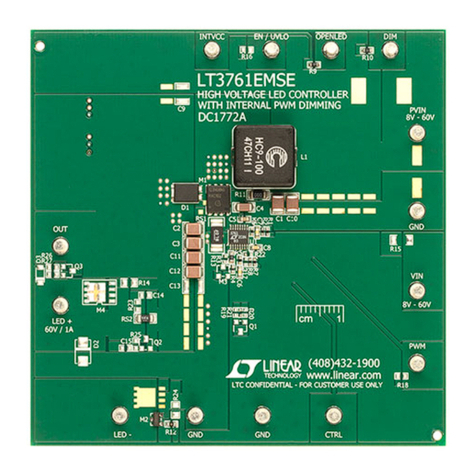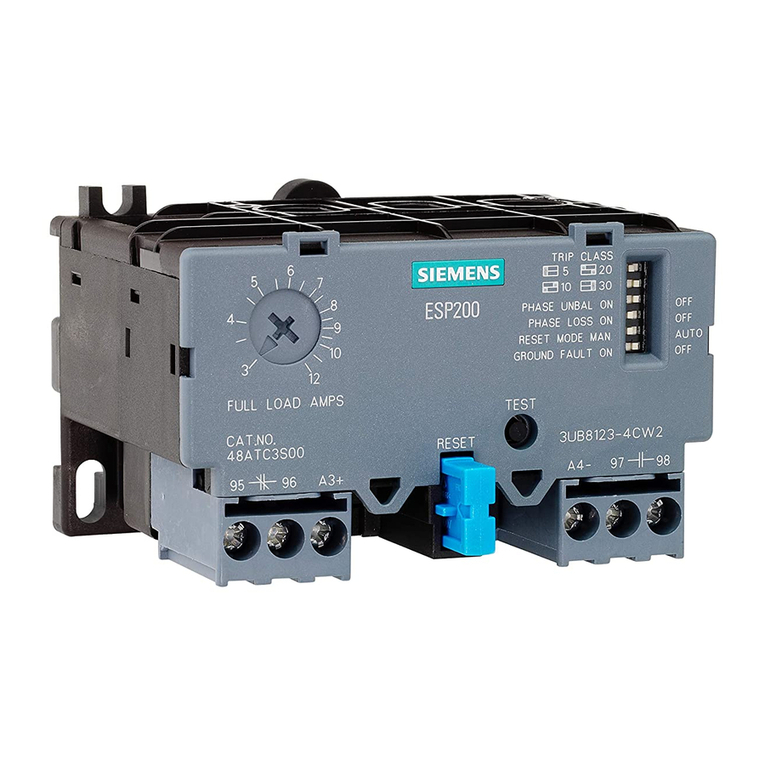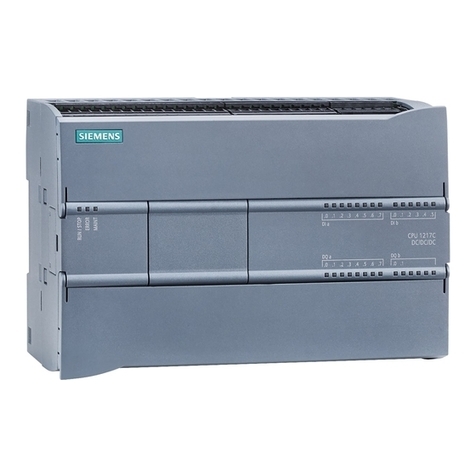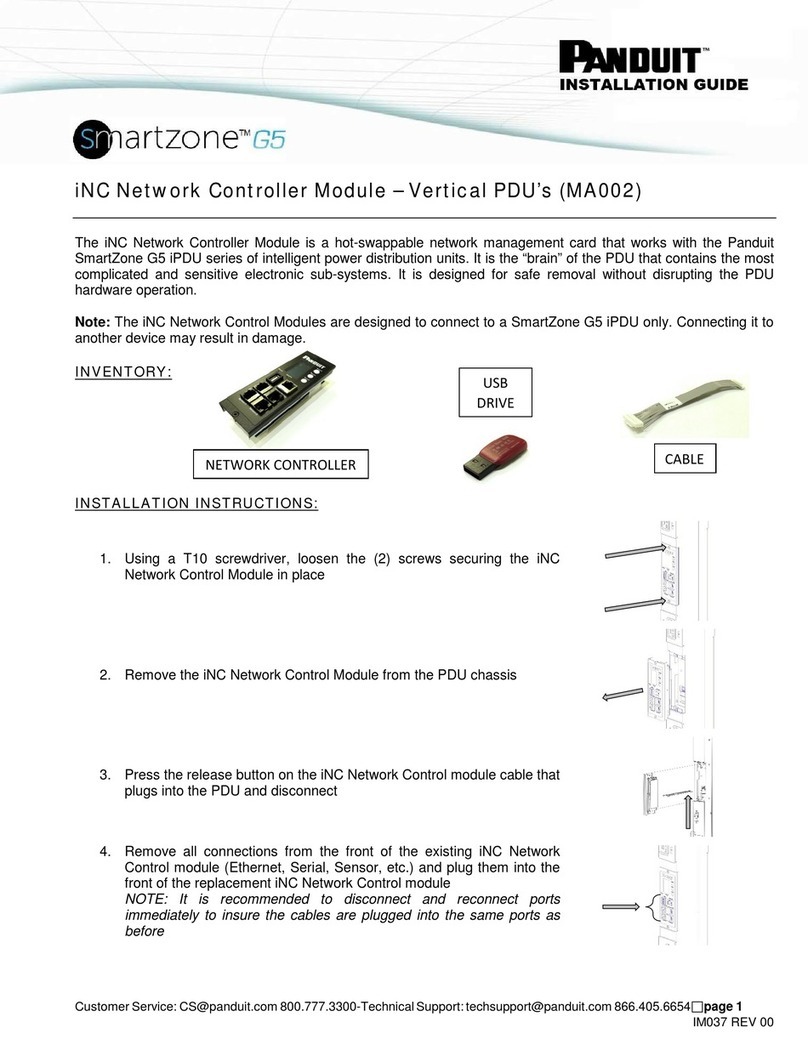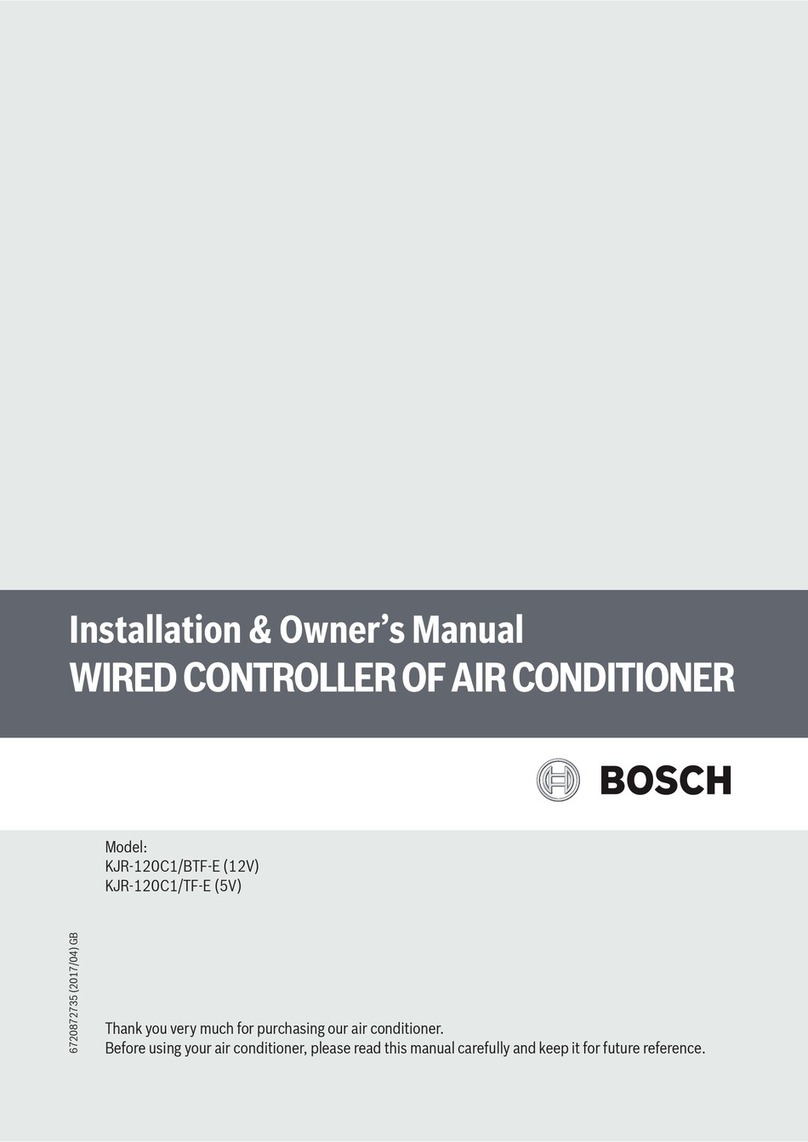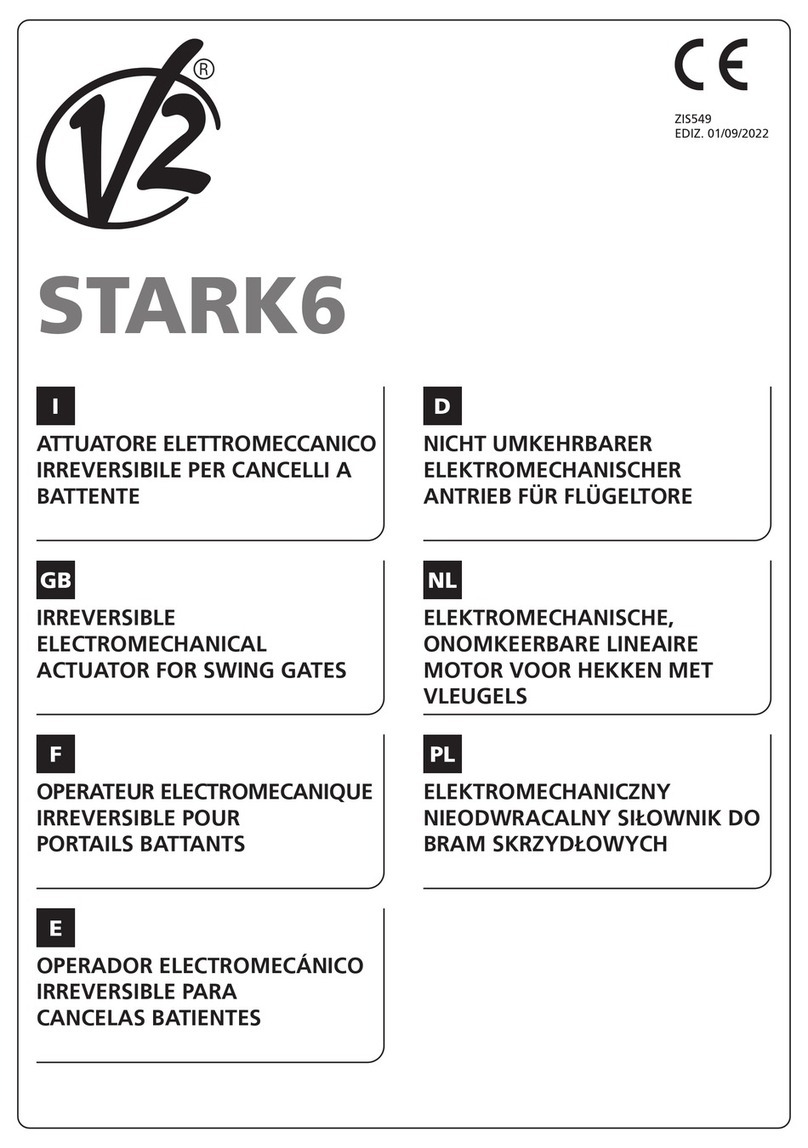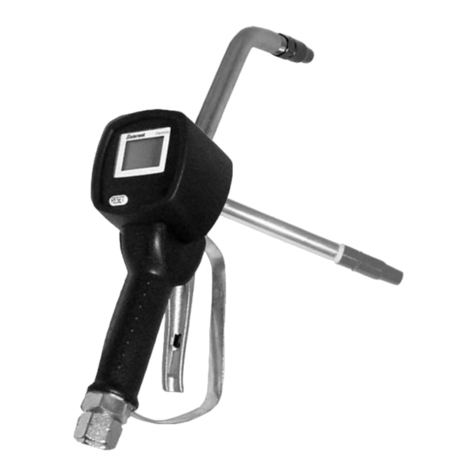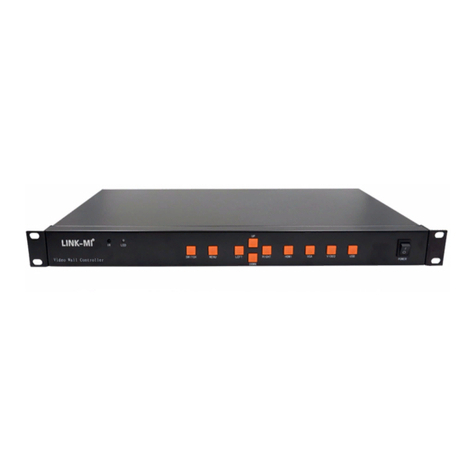Linkam Scientific Instruments MDS600 User manual

MDS600
Motorised Temperature Controlled Stage
Linkam Scientific Instruments
USER GUIDE

2
Contents
Before Setting Up Your Equipment……………………………………………………………………………………...3
Important Notice...................................................................................................................4
Warranty..............................................................................................................................4
Technical Support…………………………………………………………………………………………………………..….4
Equipment Maintenance........................................................................................................4
Handling Liquid Nitrogen.......................................................................................................4
Feedback..............................................................................................................................4
Safety Precautions................................................................................................................5
Symbol Reference.............................................................................................................5
Introduction..........................................................................................................................6
MDS600 Stage Specification..............................................................................................6
MDS600 System....................................................................................................................6
Stage Anatomy.....................................................................................................................7
Stage Assembly................................................................................................................7
Lid Assembly....................................................................................................................7
Mounting Stage to Microscope with Dovetail Substage.............................................................8
Setting up the Condenser For Koehler Illumination..............................................................7
Vacuum Tweezers.................................................................................................................9
Connecting the Instruments.................................................................................................10
T95 System Controller Cable Connections.........................................................................10
LNP95 Cooling Pump Connection.....................................................................................11
Remove Transit Screws............................................................................................11
Back Panel Cable Connection....................................................................................11
Setting Up ECP Water Circulator Pump.............................................................................12
Sample preparation.............................................................................................................13
MDS/CC Crucible Carrier and Quartz Crucible....................................................................13
MDS/CC Crucible carrier and Stainless Steel Ring…………………………………………………………...14
Cooling Connections............................................................................................................16
Purging Procedure...............................................................................................................17
Use LinkPad to set the LNP95 to Manual Mode..................................................................17
Filling the Liquid Nitrogen Dewar.....................................................................................17
Purging the Stage Method 1............................................................................................18
Purging the Stage Method 2............................................................................................19
Using Linksys32 Software with MDS600 Stage…………………..……………………………………………….20
Motorised XY Control……………………………………………….……………………………………………...….20
MDS Setup Menu……………………………………………………………………………………..………………...21
Using LinkPad with MDS600 Stage…………………………………………………………………..………………..22
Appendix............................................................................................................................23
Replacing MDS/CC Crucible Carrier………………………….…………………………………………………..…...23
G10MT Sample Holder and Sample Mapping……………………………………………………………………...25
G10MT Sample Holder and Quartz Sample Window……………….……………………………………...25
Sample Preparation Using G10MT Sample Holder……………….………………………………………...26
Sample Mapping Using Linksys32 Software……………………………………………….………………….27
Window Assembly...............................................................................................................30
Lid Window Assembly....................................................................................................30
Bottom Window Assembly..............................................................................................30
Spares and Accessories........................................................................................................31
Troubleshooting..................................................................................................................33
Contact Details....................................................................................................................36

3
Before Setting Up Your Equipment
Please register your products by going to www.linkam.co.uk and click on the
product/software registration button.
You will need to register your equipment with us to:
Activate your warranty and technical support
Access the online setup videos
Permanently unlock the Linksys32 software (if purchased)
If you have purchased Linksys32 software, please install the software first. This pro-
cess will guide to register all of your products.
See Linksys32 manual for further installation instructions.
A CD with a setup videos is supplied with your system.

4
Important Notice
Please check that your Linkam equipment has not been damaged during transit. If there is any evidence of
external damage DO NOT SWITCH ON ANY ELECTRICAL ITEMS.
Contact LINKAM SCIENTIFIC or their appointed distributor immediately. Your warranty may be im-
paired if Linkam is not informed of any transport damage within 7 working days of delivery.
NO attempt should be made to repair or modify the equipment in any way, as there are no user replaceable
parts.
No attempt should be made to open the case except by qualified personnel as hazardous voltages are pre-
sent.
In order to use this equipment successfully, please take time to read this manual all the way through before
using it.
Warranty
This equipment has a warranty against defects in material and workmanship for a period of 12 months.
Linkam will either repair or replace products that prove to be defective. For warranty service or repair,
this product must be returned to Linkam or a designated service facility.
The warranty shall not apply to defects resulting from interfacing, unauthorized modification or misuse,
operation outside of the environmental specifications for the product, or improper site preparation or
maintenance.
Technical Support
Any technical questions or queries should be addressed to the Technical Support Department at the ad-
dress shown on the back of this manual.
Equipment Maintenance
Use a small quantity of isopropyl alcohol with a soft cloth and gently wipe the surface. To clean the hot-
stage, use isopropyl alcohol (IPA) and cotton swabs. Take great care not to touch the platinum tempera-
ture sensor protruding from the side of the heating element. The sensor is very fragile.
Handling Liquid Nitrogen
To cool samples below room temperature a LNP95 liquid nitrogen pump is required. Please refer to your
health and safety manual for instructions on how to handle liquid nitrogen safely. The Dewar supplied
with the LNP95 has a safety release valve built into the siphon assembly. Always use in a well ventilated
room.
Feedback
Your feedback will be greatly appreciated, please go to www.linkam.co.uk to fill in the Feedback form.

5
Safety Precautions
1) Read this guide before using the equipment. Save these instructions for later use.
2) Follow all warnings and instructions which may be placed on the programmer or stage.
3) If for any reason the mains fuse needs to be replaced then it must be replaced by one of the same
type and rating as shown in the equipment ratings.
4) To prevent electric shock, do not remove the cover of the controller or associated electronics.
5) Never use the equipment if a power cable has been damaged. Do not allow any heavy objects to
rest on the power cables. Never lay the power cables on the floor.
6) Do not obstruct any ventilation holes. Do not attempt to insert anything into these openings.
Provide adequate ventilation of at least 75mm all around the equipment.
7) Do not expose the equipment to water. If for any reason it gets wet then unplug it from the mains
and contact Linkam Scientific Technical Support.
8) The equipment is not intended to be used outdoors.
9) Each product is equipped with a 3-wire grounded (earth) mains plug or a free-end 3 wire
mains lead. The plug only fits into a grounded-type outlet. The free-end mains lead should be
connected to a correctly grounded 3-wire mains outlet. Do not defeat the purpose of the grounded
(earth) type plug.
Free - end mains leads are colour coded as follows :
Colour Function
Brown Live
Blue Neutral
Green/Yellow Earth (Ground)
10) If any problems occur then unplug the equipment from the mains outlet and contact Linkam Sci-
entific Technical Support.
11) Do not remove the cover from the equipment unless the mains inlet has been removed. Any
servicing should be carried out by qualified service personnel.
Symbol Reference
Caution:
This safety symbol is on the back panel of the equipment and warns:-
The user must not make or remove any connections while the unit is powered on.
To avoid electric shock do not remove the cover. Refer servicing to qualified service personnel.
Caution:
This warning symbol indicates that the surface labelled with this symbol may be hot.

6
Introduction
Thank you for purchasing the MDS600 motorised
temperature controlled stage system. Please take
the time to read through the manual as it will help
you to make the most out of the equipment.
Visit our website (www.linkam.co.uk) to register
your equipment, this will ensure that we can
update you if there are any firmware updates
available to your System Controller and/or
Linksys32 software
MDS600 Stage Specifications
Maximum temperature: 600°C
Minimum temperature: -196°C
Maximum heating rate: 150°C/min
Objective Lens WD: 4.6mm
Condenser lens WD: 12.5mm
XY travel distance: 15mm
Maximum Speed: 6000µm/s
Minimum speed: 0.1µm/s
Aperture hole: 2mm
Weight: 1.2Kg
MDS600 System
The system consists of a MDS600 stage, a T95-
LinkPad System Controller, a LNP95 liquid nitro-
gen cooling pump system and Linksys32 soft-
ware.
Linksys32-DV (digital video) or Linksys32-AV
(analogue video) video capture software can be
added as an option.
Please install the Linksys32 software first and
activate the licence key. See Linksys32 manual
for more information.
The MDS600 stage is mounted onto the micro-
scope by using either specific stage clamps or an
adaptor plate.
MDS600 System

7
Stage Anatomy
Stage Assembly
1. Stage body water connector
2. XY Motor cables
3. Gas purge valve
4. Liquid nitrogen cooling connector
5. Manual X-Manipulator thumbscrew
6. X– manipulator motor
7. Y-manipulator motor
8. Manual Y-Manipulator thumbscrew
9. Stage body
10. Lemo connector for stage lead
11. Gas purge valve
12. Stage body plate cover screw
13. Stage chamber
14. Seeding post. Only available for MDBCS196
15. Stainless steel cooling tube
16. Warm post. Only available for MDBCS196
17. Sample carrier (MDS/CC)
18. Heating element wire
19. Platinum temperature sensor
20. Aperture hole
21. 22mm diameter pure silver heating block
Lid Assembly
The Stage Lid is removed from the stage by un-
screwing anti-clockwise.
22. Stage Lid
23. Lid Insert
24. Viewing Window (22 x 0.17mm glass)
25. Holes for Tube Clip Holder or window
removal tool
22
23
25
24
1
2
3
4
5
7
6
8
9
11
10
12
13
14
15
16
17
18
19
20
21

8
Mounting Stage to Microscope
with Dovetail Substage
The following description is for mounting the
stage on to microscopes which have a circular
dovetail substage assembly (1).
Attach the curved stage clamps (part no. 9541) to
the base of the stage using the supplied hex
screws and the outer most holes in the base plate.
Adjust the two positioning thumbscrews (2) and
locking thumbscrew (3) so that approximately
5mm of thread is exposed on the inside edge of
the clamp. This will roughly position the stage in
the centre of the dovetail.
Place the stage onto the dovetail, then focus a
10X objective lens on the aperture of the silver
block. Using the two positioning screws (2)
ensure that the aperture is in the centre of the field
of view and lock the stage in place by tightening
the Locking Thumbscrew (3).
For other types of microscope substage, refer to
the diagram included with the stage adaptor.
Setting up the Condenser for Koehler
Illumination.
Place a small sample on a cover slip and place
onto the surface of the silver block. Use a 5X or a
10X lens to focus on the sample. Now close
down the microscope field diaphragm and adjust
the condenser focus so that the edges of the dia-
phragm are in focus. Now use the condenser
positioning screws to centre the condenser in your
field of view. Open the diaphragm so that it just
fills the field of view.
For more information about Koehler illumination
see the extremely informative ‘Microscopy Pri-
mer’ on the Molecular Expressions website.
http://micro.magnet.fsu.edu/primer/
index.html
9541 curved clamps set
1
2
2
3
Linkam Imaging Station
with dovetail substage
1

9
Vacuum Tweezers
The vacuum tweezers are used to manipulate the
sample windows onto the silver block to prevent
fingerprints on the glass and scratching the sur-
face of the silver block when using standard fine
tip metal tweezers.
The System is supplied with a Vacuum Tweezers
Kit which consists of a Vacuum Pump (1) and
tweezers (2).
Connect the tubing at the end of the tweezers to
the Regulator Valve (3) connection.
Use the dial on the valve to adjust the vacuum for
the tweezers.
Use a finger to block the hole of the tweezers to
pick up a sample cover slip with the suction cup.
Release the finger to drop the sample cover slip.
1
2
To vacuum pumpTo tweezers
3

10
Connecting the Instruments
T95 System Controller
Cable Connections
For more details on the T95 System Controller
please refer to the T95 System Controller manual.
Connect the Stage Cable to the Lemo Connector
on the stage and connect the other end to the
Stage Connection Socket (1).
Connect the cable from the stage labelled ‘MOT
X’ to Slot 1of the T95; labelled ‘MOT X’ (2).
Connect the cable from the stage labelled ‘MOT
Y’ to Slot 2 of the T95; labelled ‘MOT Y’ (3).
T95 back panel
1
23

11
LNP95 Cooling Pump Connection
Remove Transit Screws
Before using the LNP95 Liquid Nitrogen Pump
System, remove the 4 transit screws, marked by
small yellow labels, from the base of the LNP95.
Transit screws shown by arrows in the adjacent
image. These screws hold the pumps in place for
shipping.
Keep the screws safe by screwing them into the
holes on the back panel as shown by the arrows.
The screws must be replaced back into the transit
holes on the base, when shipping back to Linkam
for service or repair.
Back Panel Cable Connection
Connect the Instrument Bus Cable (2) between
the LNP95 and T95 as shown.
Note: either of the purple coloured Instrument
Bus Sockets on the LNP95 can be used.
Important: THE LNP95 MUST BE
SWITCHED ON BEFORE T95 SYSTEM
CONTROLLER
T95
LNP95
2

12
Setting Up ECP
Water Circulator Pump
If you have purchased the ECP with the system,
read the following to set up the ECP with the
MDS600 stage. Refer to the ECP manual for
more details.
When heating the stage above 300°C for a pro-
longed period of time, the metal casing body of
the stage can get quite hot. Connect the tubing
from the ECP as shown in the opposite picture to
cool the stage.
Note: the performance of the stage is not affected
whether the ECP is in use or not.
Note: If you have an LNP95 Liquid Nitr ogen
Cooling system, the tubing from the Dewar must
not be connected to the MDS600 stage when
heating above 300°C. The thin black capillary
tube will melt inside the heater and damage it.
ECP Inlet ECP Outlet

13
Sample Preparation
For accurate results it is most important that the
surface of the block, window and carrier are ex-
tremely clean, since air gaps between the silver
block and the sample window will result in tem-
perature errors.
The block is made of silver and since it is a soft
metal it can get scratched easily especially by
using sharp fine tweezers. This can cause a ridge
to form which prevents the sample window from
sitting flat on the block with the resulting air gap
causing significant temperature errors.
For this reason we recommend that the sample
and windows are always handled using the
Linkam Vacuum Tweezers.
MDS/CC Crucible Carrier
and Quartz Crucible
The MDS/CC sample holder (1) is used to load
larger volume liquid samples using the Quartz
Crucible.
The MDS/CC is fitted on to the MDS600 stage
and hovers a few millimetres above the silver
heating block.
Place the quartz crucible (2) into the MDS/CC
sample holder by placing the crucible into the
aperture at the end of the holder. Tap the edge of
the crucible and make sure the crucible sits flat on
top of the silver block.
1
2

14
Pipette the sample into the Quartz Crucible. Use
as little sample as possible to ensure a small ther-
mal load and therefore better temperature sensi-
tivity.
Place a W13G (13 x 0.17mm) (1) glass cover slip
on top to flatten the sample.
Microscope objectives require a flat surface to
give maximum field of view.
MDS/CC Crucible Carrier
and Stainless Steel Ring
This sample loading method is likely to be more
routinely used than the Quartz Crucible as the
16mm glass sample cover slips can be discarded
after each experiment.
Place the Stainless Steel Ring (2) within the
MDS/CC.
Tap the edge of the ring lightly to ensure that it
has dropped through the aperture of the MDS/CC
and sits properly on the surface of the silver
block.
It is critical that the ring is able to move freely
inside the aperture of the sample holder and sits
flat against the surface of the silver block.
The Stainless Steel Ring is used to push the
16mm cover slip around the surface of the block
when using the motorised XY manipulators.
1
2

15
Use the vacuum tweezers or a pair of tweezers as
shown and place a W16G (16 x 0.17mm) (1) glass
cover slip (1) into the stainless steel ring.
Tap the edges lightly to ensure that it sits flat
against the surface of the block. If the cover slip
does not sit perfectly flat against the temperature
controlled surface the heat flow will be compro-
mised and the sample temperature will be signifi-
cantly different to the displayed temperature. The
Stainless Steel Ring is used to push the 16mm
cover slip around the surface of the block when
using the motorised XY manipulators.
Using a pipette or tweezers or spatula place the
sample on the 16mm cover slip. Ensure that the
sample is as small as possible and that it is as flat
as possible. Heat flow into or out of the sample is
affected by the amount of sample area in contact
with the temperature controlled cover slip.
Place a second 16mm cover slip on top of the
sample and gently tap the top with the back of the
vacuum tweezers to disperse powder samples to
ensure good thermal contact of irregularly shaped
samples and to create a flat surface for the micro-
scope lens to focus on.
Accurate temperatures can be obtained by keep-
ing the sample as small and flat as possible.
1

16
Cooling Connections
These connections need only be made if the
experiments are to be carried out below room
temperature.
The Dewar siphon (1) is the thick white foam
tubing and is attached to the liquid nitrogen Dew-
ar. The thin black capillary tube inside the white
foam tube must be inserted into the liquid nitro-
gen cooling connectors on the stage.
The white tubing slides on to the outside of the
connector. Twist the siphon whilst sliding it on
and push until it comes to a stop. It does not need
to go all the way to the base of the connector.
The thicker silicon tube from the LNP95 cooling
pump ends in a white PTFE connector (2), this is
pushed over the end of the other stainless steel
connector as seen in the image.
The short tube branching from the side of this
white connector is the Gas Purging Tube (3).
There is a valve opening Insert connector (4)
inserted into the end of this tube. During the
purging procedure, insert this connector into the
Gas Purge Valve (5) on the side of the stage to
open it.
The Gas Purge Valve (5) is opened when the Gas
Insert (6) is pushed firmly into the connector, a
“click” is heard when the two parts are connected
properly. To remove the Gas Insert, push the
outer sleeve of Gas Purge Valve toward the stage
and the Gas Insert (6) should drop out.
There is a second Gas Purge Valve on the oppo-
site side of the stage to allow the gas to leave the
stage. A Gas Insert must also be inserted into this
Gas Purge Valve (7) when purging.
The smaller tube from the outlet on the LNP95
should be placed in position on the top of the lid
using the Tube Clip Holder (8). This tube blows
warm recycled nitrogen gas across the lid window
to prevent condensation on the viewing window
surface.
8
1
2
3
4
7
5
6
8

17
Use LinkPad to set the LNP95 to
Manual Mode
Touch the active area (1) under ‘Lnp speed’ to
change to the LNP Screen Menu. Touch
’Man’ (2) to switch the LNP95 to manual mode.
The word ‘auto’ is changed to ’speed’ to indicate
the LNP95 is functioning in manual mode.
Using the Keypad type in 100 (max pump speed)
and touch the ’Enter’ button (4) to start the
LNP95 at the programmed speed (5).
Filling the Liquid Nitrogen Dewar
Please follow your health and safety manual for
directions on how to handle liquid nitrogen and
ensure that you have the correct safety equipment
including gloves and safety goggles.
Fill the Dewar until approximately 2/3 full and
replace the lid with siphon attached.
DO NOT FASTEN THE CATCHES.
Wait for the nitrogen to stop bubbling before
fastening the catches.
Take care when placing lid on a table to always
have the black capillary pointing upwards. It is
easily damaged which will impair N2 flow.
1
2
4
5
Purging Procedure
Before starting a cooling experiment, you will need to purge air from the stage chamber with dry nitro-
gen . This will remove the water in the air which would otherwise condense and freeze on the sample
disrupting your image quality.
Before you can start purging, the LNP95 must be set to manual mode.
You can either use the LinkPad touch screen or Linksys32 software.

18
Purging the Stage Method 1
There are two methods for purging the stage. Method 1 uses recycled nitrogen gas produced by the
LNP95 from the 2L Dewar.
1. Make sure the stage lid is in place and the stage door is closed.
2. Switch on the temperature programmer and set the limit to 40°C. Press the START button and
wait until the temperature limit is reached. Press HOLD to hold the temperature at 40°C.
3. Switch on the LNP95 cooling system and set it to manual mode, (see page 17) and set the speed to
maximum of 100.
4. Check that the Gas Inserts are locked into place
5. Using a finger on the left hand, block the hole in the white plastic pump connector found on the
perpendicular side to the purging tube. Still working with the left hand, pinch the narrow window
tube to block it. This action will divert all of the nitrogen gas to the Purging Tube and through the
Stage Chamber.
6. With the nitrogen gas flowing through the Sample Chamber, use a finger on the right hand to
block the gas outlet for a few seconds to allow pressure build, then release the gas . Do this for a
few minutes to purge the stage.
7. Look at the change of reflection in the stage window as the stage is pressurised and released to
check that the stage is properly sealed. If there is no change, there may be a leak due to incorrect
placing of the silicon o-rings in either the bottom or lid window or the window (top/bottom may
be broken).
8. The purging procedure allows mixing of nitrogen gas with the residual air inside the Sample
Chamber. By pressurising the chamber with nitrogen gas and releasing it, the air inside the
Chamber is being diluted with the nitrogen gas.
9. Remove the two Gas Inserts and unblock the pump connector and window tube.
10. Change the LNP95 to AUTOMATIC mode so that the T95 automatically controls pump speed
during your cooling experiment
11. Go to www.linkam.co.uk and register your equipment to see videos of how to purge and more.
Pinch window tube
with right hand
Block hole in
Connector with finger
Purging
tube
Block and release outlet
valve with finger

19
Purging the Stage Method 2
This method uses an inert gas from a gas cylinder
to purge the stage at temperatures above ambient
when the LNP95 is not required.
1. Make sure the Stage Lid is in place and the
Stage Door is closed.
2. From a gas cylinder connect the Gas Insert
with a tubing 3mm inner diameter and 6mm
outer diameter to the Gas Purge Valve (1).
3. Connect a Gas Insert to the opposite side Gas
Purge Valve (2).
4. Use the gas regulator to set a gas flow rate of
1.5L/min.
5. With the gas flowing through the Sample
Chamber, block the gas outlet for a few sec-
onds and releasing the gas outlet valve with a
finger. Do this for a few minutes to purge the
stage.
Reduce the gas flow rate to 20cc/min to continu-
ously purge the stage or remove the two Gas
Inserts to keep the chamber under closed inert
atmosphere.
Note: Helium gas is not recommended for contin-
uous purging. This gas has a very high thermal
conductivity and will cool the silver heating block
too much during an experiment and may cause the
temperature to fluctuate.
1
2
1
To gas
cylinder
Block and release
outlet valve with
finger

20
Using Linksys32 Software with MDS600 Stage
Please refer to Linksys32 manual to control the temperature of the MDS600. With Linksys32-DV/AV for
digital video/analogue video capture. The following chapter will provide extra information to control the
motorised XY manipulators using Linksys32 software and automatically map a sample using Linksys32-
DV/AV software with a camera.
Motorised XY Control
When connected there is an additional Motorised Tool Bar (1) in the main screen of Linksys32.
1. Goto Position, continue a paused step move or stor ed position move
2. Pause Motion, pause a step move or stor ed position move
3. Stop Motion, stop a step move or stor ed position move
4. Goto Reference, move to the reference position
5. Goto Stored Position, move to the displayed Stored Position
6. Goto Post, move to the War m Post when using G7MTB Sample Holder. Only available for
MDBCS196
7. Save the Current Position, saves the cur rent XY values into the displayed Stor ed Position
8. Delete the Current Stored Position, deletes the XYZ values stored in the displayed Stored Position
9. Change Motion to Step Move / Change Motion to Freely Move, Used to change to joystick opera
-tion between step and free movement (step size is setup in the MDS setup table)
10. Joystick, hold the mouse left button down and move the mouse ar ound to move in X and Y
11. X Possition, display the cur r ent X position
12. Y Possition, display the cur rent Y position
13. Z Possition, inactive with MDS600
14. Motor Status, Status of XY Motor, Stopped or Moving
15. XY Velocity, speed selection for XY motor s. Use the up or down ar row / Nudge Control to se-
lect a preset Speed (Fine, Medium or Rapid), see MDS Setup Menu, page 20
16. Z Velocity, inactive with MDS600
17. Stored Position, stor ed position number selected (1-150), use the up or down arrow / Nudge Con-
trol to select the stored position number
123456789
10
11 12 13 14
15 16 17
Table of contents
Other Linkam Scientific Instruments Controllers manuals
